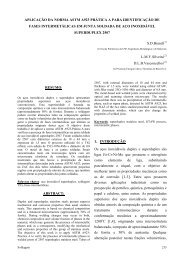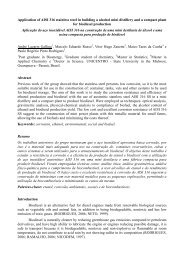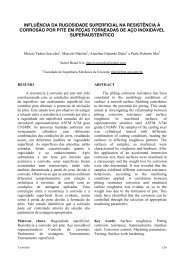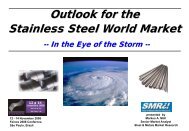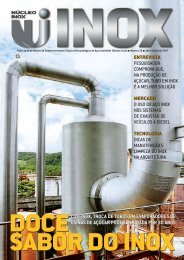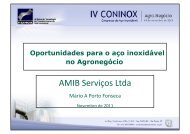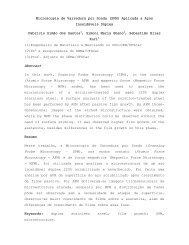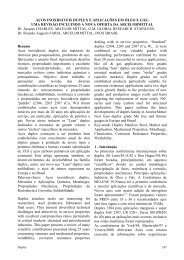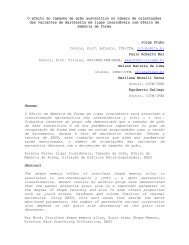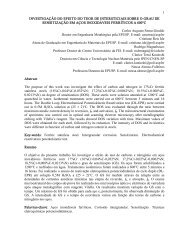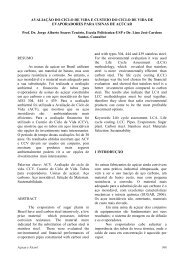Orbital Welding of Duplex Stainless Steel Tubing and
Orbital Welding of Duplex Stainless Steel Tubing and
Orbital Welding of Duplex Stainless Steel Tubing and
Create successful ePaper yourself
Turn your PDF publications into a flip-book with our unique Google optimized e-Paper software.
<strong>Orbital</strong> <strong>Welding</strong> <strong>of</strong> <strong>Duplex</strong> <strong>Stainless</strong> <strong>Steel</strong> <strong>Tubing</strong> <strong>and</strong> Pipe for Critical Offshore Applications<br />
Soldagem <strong>Orbital</strong> de Tubos de Aço Inoxidável <strong>Duplex</strong> e Tubulação para<br />
Aplicações Offshore Críticas<br />
Barbara K. Henon, Ph.D. <strong>and</strong> Eng. Angel Brond<br />
Arc Machines, Inc.<br />
Abstract<br />
Over the last decade or two extremely harsh <strong>of</strong>fshore <strong>and</strong> subsea environments have m<strong>and</strong>ated the<br />
development <strong>of</strong> improved grades <strong>of</strong> duplex stainless steels. These newer materials have the ability to<br />
retain a good balance <strong>of</strong> austenite <strong>and</strong> ferrite <strong>and</strong> thereby toughness <strong>and</strong> corrosion resistance in the<br />
welded condition. However, in order to retain the desirable properties <strong>of</strong> these technically complex<br />
materials, special care <strong>and</strong> attention is required for the joining <strong>of</strong> tubing <strong>and</strong> pipe.<br />
<strong>Orbital</strong> GTA welding with preprogrammed weld schedules provides maximum parametric control <strong>and</strong><br />
repeatability <strong>of</strong> process <strong>and</strong> is preferred to manual welding <strong>of</strong> duplex stainless steel wherever practical.<br />
The fine control <strong>of</strong> heat input makes it possible to meet the highest quality specifications for phase<br />
balance, corrosion resistance <strong>and</strong> mechanical strength. A major advantage <strong>of</strong> orbital welding over<br />
manual welding is that once a procedure has been established for a particular duplex alloy, consistent<br />
welds which meet all <strong>of</strong> the requirements <strong>of</strong> the qualified test coupons can be achieved with a high<br />
degree <strong>of</strong> repeatability throughout a project.<br />
The use <strong>of</strong> orbital GTA welding for subsea <strong>and</strong> <strong>of</strong>fshore applications includes autogenous welding <strong>of</strong><br />
small diameter 0.250 inch tubing, as well as tubing installations on subsea “Christmas Tree” well<br />
heads. <strong>Orbital</strong> GTA welding with filler metal has also been done successfully on small diameter super<br />
duplex 2507 (UNS 32750) tubing for subsea umbilical coils as well as for large diameter headers.<br />
A recent example <strong>of</strong> orbital welding <strong>of</strong> larger diameter duplex stainless steel pipe was done for the<br />
800,000 barrel P-52 Platform. Built at the BrasFELS Shipyard in Angra dos Reis, Brazil <strong>and</strong> owned by<br />
Petrobras; this is the largest <strong>of</strong>fshore platform in the world. The installer welded 22 inch Schedule 80<br />
2507 (UNS 32750) duplex stainless steel pipe using two orbital welding power supplies <strong>and</strong> two fullfunction<br />
weld heads mounted on a single guide ring. The welds were accomplished with low heat input<br />
<strong>and</strong> the radiographic results were excellent. The index <strong>of</strong> repair over the six months <strong>of</strong> production<br />
welding was so outst<strong>and</strong>ing that the fabricator received a special award from the BrasFELS shipyard<br />
for production quality. This project will be described in depth.<br />
This presentation will describe orbital welding procedures <strong>and</strong> fabrication techniques as well as<br />
welding equipment used for autogenous <strong>and</strong> filler metal applications. The importance <strong>of</strong> tube <strong>and</strong> pipe<br />
end preparation, joint design, purge gas composition <strong>and</strong> purging techniques will be discussed.<br />
Resumo<br />
Durante as duas últimas décadas ambientes <strong>of</strong>fshore e submarinos extremamente severos levaram ao<br />
desenvolvimento de melhores qualidades de aços inoxidáveis duplex. Estes materiais mais recentes têm<br />
a capacidade de manter um bom equilíbrio entre a austenita e a ferrita e, assim, tenacidade e<br />
resistência à corrosão na condição de soldado. No entanto, a fim de manter as propriedades desejáveis<br />
destes materiais tecnicamente complexos, especial atenção e cuidado é necessário para a união de<br />
tubos.
Soldagem orbital TIG (GTA) com horários pré-programados de solda <strong>of</strong>erece controle paramétrico<br />
máximo e repetibilidade do processo e é o preferido a soldagem manual de aço inoxidável duplex<br />
sempre que possível. O controle preciso do aporte de calor faz com que seja possível atender às<br />
especificações de alta qualidade para a fase de equilíbrio, resistência à corrosão e resistência<br />
mecânica. A maior vantagem da soldagem orbital sobre a soldagem manual é que depois que um<br />
procedimento foi estabelecido para uma liga duplex particular, soldas consistentes que satisfazem<br />
todas as exigências do teste de amostras qualificadas podem ser obtidas com um alto grau de<br />
repetibilidade ao longo de um projeto.<br />
A utilização de soldagem orbital TIG para aplicações <strong>of</strong>fshore e submarinas incluem a soldagem<br />
autógena de tubos de pequeno diâmetro 0,250 polegadas, bem como das instalações de tubulação<br />
submarina "Árvore de Natal" que atuam como cabeças de poço. A soldagem orbital TIG com metal de<br />
adição, também foi realizada com sucesso em superduplex 2507 (UNS 32750) de pequeno diâmetro<br />
para bobinas umbilicais submarinas, bem como para os cabeçotes de gr<strong>and</strong>e diâmetro.<br />
Um exemplo recente de soldagem orbital de tubulação de aço inoxidável duplex de maior diâmetro foi<br />
feito para a Plataforma P-52, cuja produtividade é de 800 mil barris/dia. Construído no estaleiro<br />
BrasFELS, em Angra dos Reis, Brasil e de propriedade da Petrobras, é a maior plataforma <strong>of</strong>fshore no<br />
mundo. A instalada tubulação de aço inoxidável duplex 2507 (UNS 32750) de 22 polegadas de<br />
diâmetro, Schedule 80, foi realizada com duas fontes de energia de soldagem orbital e duas de solda<br />
de guia montadas em um anel único. As soldas foram realizadas com baixo aporte de calor e os<br />
resultados radiográficos foram excelentes. O índice de reparação ao longo dos seis meses de soldagem<br />
de produção foi tão notável que o fabricante recebeu um prêmio especial do estaleiro BrasFELS para<br />
a qualidade da produção. Este projeto será descrito em detalhes.<br />
Esta apresentação irá descrever os procedimentos de soldagem orbital e as técnicas de fabricação,<br />
bem como os equipamentos de solda utilizados para a execução da soldagem autógena e soldagem na<br />
qual se fez uso de metal de adição. A importância do tubo e preparação final da tubulação, o projeto<br />
conjunto, a composição do gás de purga e técnicas de purificação serão discutidos.<br />
Introduction<br />
As the development <strong>of</strong> engineered duplex stainless steel alloys for the <strong>of</strong>fshore, subsea, <strong>and</strong> deepwater<br />
industries has advanced, so has the need for advanced welding technology for these materials. <strong>Orbital</strong><br />
welding, which is defined as “automatic or machine welding <strong>of</strong> tubes or pipe in-place with the<br />
electrode rotating (or orbiting) around the work,” has been shown to <strong>of</strong>fer many advantages compared<br />
to manual for welding the new generation <strong>of</strong> duplex stainless steels. The following examples show the<br />
range <strong>of</strong> applications <strong>and</strong> range <strong>of</strong> orbital welding equipment used for welding <strong>of</strong> duplex stainless<br />
steels:<br />
In the early 1990’s, orbital welding technology was used by Cameron Forged Products Division <strong>of</strong><br />
Cooper Ltd. (Great Britain) to fabricate a super duplex (UNS S32760) test manifold for Philips<br />
Petroleum (Henon, 1992). A full-function track-mounted Model 15 weld head was used to join the<br />
specially forged tees to form the manifold used for a high-pressure application on an <strong>of</strong>fshore platform<br />
in the North Sea. (Figure 1.)
Figure 1. The Embla Test Header built by Cameron from forged super duplex tees using orbital GTA<br />
welding 11 . The Weld Procedure Specification (WPS) required preparation <strong>and</strong> examination <strong>of</strong><br />
metallographs for sigma phase <strong>and</strong> ferrite counts.<br />
(Photos from Henon, B.K., December, 1992)<br />
S<strong>and</strong>vik Chomutov Precision Tubes in the Czech Republic was one <strong>of</strong> the first companies to develop<br />
the combination <strong>of</strong> orbital welding technology with an advanced duplex grade, SAF 2507 super duplex<br />
(UNS 32507), for the fabrication <strong>of</strong> umbilical tubing used in today’s remote deepwater fields (Henon,<br />
B.K. 2001). Arc Machines, Inc. Model 227 Power Supplies <strong>and</strong> Model 95 weld heads were used for<br />
this orbital wirefeed application. (Figure 2.)<br />
Figure 2. Left: S<strong>and</strong>vik orbital welding set-up with orbital welding power supply with cooling unit <strong>and</strong><br />
orbital weld head. <strong>Orbital</strong>ly welded lengths <strong>of</strong> super duplex tubing were wound onto large coils for<br />
umbilical tubing. 100% radiography <strong>of</strong> the orbital welds was performed. (Photos from Henon, B.K.,<br />
2001)<br />
Acute Technological Services (ATS), a well-known petroleum industry support company, based in<br />
Houston, Texas USA, made an early decision to specialize in welding engineering, consulting <strong>and</strong><br />
fabrication <strong>of</strong> duplex stainless steels. ATS has developed highly specialized manual <strong>and</strong> automatic<br />
orbital welding procedures for these materials (Hayes, M.D. <strong>and</strong> B.K. Henon, 1993).<br />
Material <strong>and</strong> Methods<br />
Material. <strong>Duplex</strong> stainless steels consisting <strong>of</strong> iron alloyed with chromium, nickel, molybdenum <strong>and</strong><br />
nitrogen are engineered <strong>and</strong> manufactured to produce a material with a balanced phase microstructure<br />
<strong>of</strong> approximately 50% face centered cubic (fcc) austenite (γ) phase <strong>and</strong> 50% body-centered cubic<br />
ferrite(α) phase in the annealed condition. The balanced phase structure combines the favorable<br />
properties <strong>of</strong> austenitic <strong>and</strong> ferritic stainless steels when welded properly.<br />
Weld procedure qualification <strong>of</strong> duplex materials usually requires corrosion testing <strong>of</strong> the weldments.<br />
Ferrite counts, either point counts from sections which are destructive tests, or ferritscope<br />
measurements which can be done on tubing in the field or between passes on pipe welds are commonly<br />
made. For weldments to be placed in low temperature service, low temperature Charpy impact testing
may be required as a test for ductility. The NORSOK St<strong>and</strong>ard M-601 used by the BrasFELS Shipyard<br />
requires 100% positive material identification (PMI) for stainless steels <strong>and</strong> nickel-based materials to<br />
be used in subsea applications. This st<strong>and</strong>ard also requires the use <strong>of</strong> matching the consumable with<br />
enhanced Ni content compared to base metal in order to promote the formation <strong>of</strong> austenite during<br />
welding.<br />
Equipment. For orbital GTA welding there are basically two types <strong>of</strong> equipment: equipment for<br />
autogenous welding used to weld tube, <strong>and</strong> pipe welding equipment with the capability <strong>of</strong> adding filler<br />
wire to the weld.<br />
<strong>Orbital</strong> tube welding equipment. <strong>Orbital</strong> tube welding is a nearly automatic process in which the<br />
operator installs the tubing or components to be welded into an enclosed weld head, selects the<br />
appropriate welding program or schedule from the power supply memory, sets the ID purge flow <strong>and</strong><br />
initiates the weld sequence. The power supply controls weld parameters. There is no operator<br />
intervention during the weld sequence in which the electrode, <strong>and</strong> thus the arc, completes a single pass<br />
weld with full penetration. Water cooling <strong>of</strong> weld heads is strongly recommended, especially for wall<br />
thicknesses greater than 0.049 inch or for high production welding. The end preparation for tube<br />
welding is typically a square butt weld (no groove) with the ends precision squared by machine.<br />
<strong>Orbital</strong> pipe welding equipment. <strong>Orbital</strong> pipe welding power supplies generally provide higher welding<br />
current than tube welding power supplies <strong>and</strong> have the ability to feed wire into the weld. In addition to<br />
controlling the parameters for tube welding, they may also have electronic arc length control (AVC)<br />
<strong>and</strong> controls for torch oscillation for weaving the torch back <strong>and</strong> forth across the weld seam. For both<br />
tube <strong>and</strong> pipe systems, the weld program or schedule is stored in the memory <strong>of</strong> the microprocessorcontrolled<br />
power supply, but with pipe welding power supplies, weld parameters such as AVC,<br />
welding current <strong>and</strong> torch centering may be adjusted or modified by the welding operator during<br />
welding.<br />
There are several types <strong>of</strong> pipe weld heads. The most basic is an open-frame head such as the AMI<br />
Model 95 with wire feed that clamps onto the pipe <strong>and</strong> uses mechanical arc length control. The Model<br />
79 is a similar head which also has AVC <strong>and</strong> oscillation functions in addition to wire feed. Also<br />
available are large full-function track-mounted heads such as the AMI Model 15 for welding pipe from<br />
4 inches nominal diameter <strong>and</strong> larger. These heads move around the weld joint on a track while the<br />
pipe remains in place. Other heads for limited clearance are used for boiler tubes <strong>and</strong> heads <strong>and</strong> torches<br />
exist for a large variety <strong>of</strong> applications.<br />
<strong>Orbital</strong> Pipe <strong>Welding</strong> at BrasFELS Shipyard in Brazil<br />
The Offshore St<strong>and</strong>ard DNV-OS-F01 Appendix C <strong>Welding</strong> used by the BrasFELS Shipyard specified<br />
that mechanized <strong>and</strong> automatic welding systems where previous experience is limited or where the<br />
systems will be used under new conditions shall be subject to a more extensive prequalification<br />
program or documentation before they may be used. The Contractor was required to prove <strong>and</strong><br />
document that the welding systems were reliable <strong>and</strong> that the process could be continuously monitored<br />
<strong>and</strong> controlled.<br />
Installers at BrasFELS used two AMI full-function track-mounted Model 15 orbital weld heads<br />
mounted on the same track for welding up to 22 inch schedule 80 2507 (UNS 32750) duplex stainless<br />
steel pipe. A Model 79 open frame head was also used for welding smaller diameters up to 4 inch pipe<br />
in the pipeshop. At BrasFELS, there were two different joint configurations, pipe-to-pipe using a<br />
modified J end preparation <strong>and</strong> pipe-to-fitting which was a st<strong>and</strong>ard V groove with a 37 ½ ° bevel. The<br />
preferred end preparation for pipe welding up to about 0.500 inch wall thickness is the modified-J<br />
preparation with a l<strong>and</strong> <strong>of</strong> about 0.065 to 0.095 inches (Figure 3.) The l<strong>and</strong> extension may be adjusted<br />
depending on the material. The fittings at BrasFELS were received with a 37 ½ ° end prep which could<br />
not be machined or modified.
The PQR reflects the distribution <strong>of</strong> weld sizes <strong>and</strong> joint configurations for fully orbital welds or<br />
manual root passes combined with orbital welding. Pipe-to-elbow or tee fitting welds were done with a<br />
manual root followed by orbital filler passes, while pipe-to-pipe welds with a J end preparation (Figure<br />
4.) were completely orbitally welded. In the pipeshop the pipe was segregated by ODs larger <strong>and</strong><br />
smaller than 4 inches. (Figure 4.)<br />
.<br />
Figure 3. Left: Detail from BrasFELS’ PQR showing separation <strong>of</strong> duplex stainless steel pipe by sizes<br />
over 4 inches <strong>and</strong> 4 inches <strong>and</strong> less. It also shows manual root passes for pipe-to-fitting welds <strong>and</strong><br />
complete orbital welds for pipe-to-pipe joints. Right: A modified “J” end preparation is recommended<br />
for orbital welding <strong>of</strong> pipe.<br />
Arc Machines employee, Eng. Angel Brond, worked closely with BrasFELS to develop their PQR<br />
according to the requirements for limiting the heat input in duplex stainless steel welds listed in<br />
Offshore St<strong>and</strong>ard DNV-OS-F101, Submarine Pipeline Systems, October 2007, App. C. This<br />
st<strong>and</strong>ard requires the control <strong>of</strong> heat input to avoid detrimental weld cooling rates. In order to<br />
achieve optimum control <strong>of</strong> heat input they recommend faster welding times <strong>and</strong> higher welding<br />
currents. Stringer beads are recommended to ensure a constant heat input <strong>and</strong> any weaving <strong>of</strong> the<br />
weld bead was limited to a maximum <strong>of</strong> 3 times the filler wire or electrode diameter. In this case the<br />
wire diameter was 0.035 inches supplied by S<strong>and</strong>vik. The heat input for girth welds was limited to a<br />
range <strong>of</strong> 0.5 – 1.8 kJ/mm, with the lower end <strong>of</strong> the range specified for thinner wall pipe. It was also<br />
required that welding be continuous for an entire pass rather than stopping <strong>and</strong> starting the arc or<br />
performing a split pass.<br />
Appendix C <strong>of</strong> DNV-OS-F101 required that welding personnel be qualified to ISO 14732 <strong>and</strong> EN<br />
1418. Qualification <strong>of</strong> welding operators was done by BrasFELS with AMI consulting on site. As<br />
specified by this st<strong>and</strong>ard, the qualification tests were done on the actual equipment <strong>and</strong> premises<br />
that were used during production welding.<br />
An additional st<strong>and</strong>ard DNV-RP-F112 Recommended Practice - Design <strong>of</strong> <strong>Duplex</strong> <strong>Stainless</strong> <strong>Steel</strong><br />
Subsea Equipment Exposed to Cathodic Protection October 2008 was used as a Recommended<br />
Practice to asses the quality <strong>and</strong> repeatability <strong>of</strong> the ferrite <strong>and</strong> austenite composition <strong>of</strong> the base<br />
metal before welding <strong>and</strong> after welding.<br />
NORSOK M 601 St<strong>and</strong>ard, Edition 5, April 2008 is also referenced with respect to 4.4.4 Heat Input<br />
<strong>and</strong> 5.1 <strong>Welding</strong> Requirements. The maximum variation allowed in heat input is +/- 15%. Table A.3<br />
lists acceptance criteria for welds including the amount <strong>of</strong> weld bead reinforcement or internal<br />
protrusion. A normative annex was added in this edition with color photos for acceptable<br />
oxidations/coloration on the I.D <strong>of</strong> pipes. Color ranges from no color (good) to heavy black, brown<br />
<strong>and</strong> blue discoloration which is unacceptable. Loss <strong>of</strong> corrosion resistance has been shown to be
proportional to the amount <strong>of</strong> color (Hansen, J.V. 1997). To assure minimal discoloration, gas purity<br />
<strong>and</strong> dewpoint had to be certified <strong>and</strong> monitored at the point <strong>of</strong> use with an oxygen analyzer.<br />
NORSOK M 601 requires the use <strong>of</strong> filler metal in root passes <strong>of</strong> Type 25Cr duplex <strong>and</strong> Ni-alloys<br />
for seawater service. Filler metal on 4 inch 2 lbs spools was supplied by Bohler. A separate welding<br />
procedure (WPS) was required for repair welds. NORSOK M-601 allows only one attempt at repair<br />
in the same area. Re-welding must include complete removal <strong>of</strong> the original weld <strong>and</strong> HAZ.<br />
Results<br />
BrasFELS welding <strong>of</strong> super duplex pipe<br />
The BrasFELS Shipyard was very successful in orbital welding <strong>of</strong> all <strong>of</strong> their sizes <strong>of</strong> super duplex<br />
stainless steel pipe. Their welding operation lasted for 1-1/2 years welding two shifts per day. The<br />
results <strong>of</strong> radiographic examination were excellent with a very low reject rate. BrasFELS passed the<br />
very stringent maintenance audit <strong>of</strong> the ISO 9001:2000 certification conducted by Bureau Veritas<br />
Quality International (BVQ1) with flying colors. They received an award from Petrobras for their<br />
excellent welding.<br />
Figure 4. Left: <strong>Orbital</strong> welding <strong>of</strong> 2507 (UNS 32750) 20 inch duplex pipe with the AMI Model 15 <strong>and</strong><br />
4 inch pipe with the Model 79 weld heads in the prefabrication environment in the pipeshop at the<br />
BrasFELS Shipyard in Brazil. Right: Some orbital welds on pipe <strong>and</strong> fittings for the Petrobras P-52<br />
Platform. Photos from Arc Machines, Inc.<br />
Discussion<br />
In deepwater installations, defined as over 1,000 feet or more beneath the surface, materials are<br />
expected to perform under higher pressures (15,000 psi) <strong>and</strong> to withst<strong>and</strong> higher temperatures (300°<br />
Fahrenheit) than ever before (Chater, J., 2007). To satisfy the requirements for deepwater applications,<br />
the use <strong>of</strong> stainless steels, especially duplex <strong>and</strong> super duplex have become nearly indispensible. Since<br />
proper welding <strong>of</strong> these materials is essential for maintaining their corrosion resistance <strong>and</strong> mechanical<br />
properties it is absolutely critical that good welding procedures be developed <strong>and</strong> carried out in a<br />
repeatable manner throughout a project.<br />
Each application <strong>of</strong> duplex <strong>and</strong> super duplex material is unique <strong>and</strong> weld procedures must be developed<br />
accordingly. The steel tube umbilical must be manufactured to meet the requirements <strong>of</strong> the specific<br />
subsea application which varies with environmental conditions. Material selection <strong>and</strong> welding<br />
procedures must be determined independently for each individual project.
It is generally agreed that duplex stainless steels benefit from the addition <strong>of</strong> filler metal overalloyed in<br />
nickel <strong>and</strong> nitrogen. However, for some small bore tubing, acceptable ferrite counts <strong>and</strong> corrosion<br />
resistance have been achieved with autogenous welding. This has been accomplished by the use <strong>of</strong><br />
shield gas containing helium, argon <strong>and</strong> 2% nitrogen (Hayes, M.D. <strong>and</strong> B.K. Henon, 2002).<br />
<strong>Orbital</strong> welding <strong>of</strong> duplex stainless steel for subsea umbilical tubing is continuing. Several<br />
manufacturers <strong>of</strong> coiled tubing have told AMI, that this would not be possible without the use <strong>of</strong> orbital<br />
welding. Umbilical tubing is typically welded with a Model 95 or a Model 79 weld head feeding wire.<br />
AMI has recently been active in assisting with the development <strong>of</strong> the PQR/WPS for umbilical tubing<br />
in Brazil.<br />
Petrobras in Brazil is a major player in this industry. The P-52 platform, recently commissioned, is<br />
largest in the world. BrasFELS Shipyard was given an award by Petrobras for their excellence. Weld<br />
criteria for duplex stainless steels must include ferrite counts or evaluation <strong>of</strong> the mechanical properties<br />
<strong>of</strong> the weldment since a good looking weld alone does not assure a good weld. A weld can have a good<br />
appearance while still have unacceptable ferrite numbers or deleterious phases that result in<br />
embrittlement. In order to accomplish repeatable welds with all <strong>of</strong> the favorable properties <strong>of</strong> the<br />
qualification welds, there must be proper <strong>and</strong> repeatable end preparation, joint configuration, purging<br />
techniques, <strong>and</strong> operator training.<br />
Installers must be aware <strong>of</strong> the unique properties <strong>of</strong> the material <strong>and</strong> to underst<strong>and</strong> the need for strict<br />
adherence to the qualified weld procedures (WPS). Precise, consistent control <strong>of</strong> heat input is essential.<br />
In addition, purging with inert gas is even more critical for duplex than for austenitic stainless steels for<br />
the retention <strong>of</strong> corrosion resistance. The recommendations for cleaning, end-preparation, welding<br />
environment, purging for manual welding <strong>of</strong> duplex stainless steels (Messer et. al, 2010) apply to<br />
orbitally welded duplex stainless steel as well.<br />
The PQR for the Petrobras duplex stainless steel pipe made specific requirements for welding <strong>of</strong> duplex<br />
stainless steel, as outlined in the S<strong>and</strong>vik <strong>and</strong> DNV St<strong>and</strong>ards that would be very difficult to achieve by<br />
manual welding. To our knowledge this is the first time that a specification has gone so deeply into the<br />
details <strong>of</strong> a welding procedure. Compliance with the requirement for stringer beads or limiting the<br />
amount <strong>of</strong> oscillation <strong>of</strong> the weld bead, the upper <strong>and</strong> lower limits <strong>of</strong> heat input per pass with a maximum<br />
<strong>of</strong> 0.5-2.5 kJ/mm (10-65 kJ/inch), <strong>and</strong> the requirement for continuous welding virtually dem<strong>and</strong>ed the use<br />
<strong>of</strong> mechanized or orbital welding equipment.<br />
<strong>Orbital</strong> welding with a proven WPS is the most reliable method for welding <strong>of</strong> duplex alloys.<br />
Unfortunately, installing contractors using manual welders working in the pipeshop or field environments<br />
are not always able to consistently meet the same quality requirements as those <strong>of</strong> the qualification welds<br />
that were done under ideal conditions. There have been several occasions when manually welded duplex<br />
<strong>and</strong> super duplex weldments have failed in service. It should be apparent that working in the deepwater<br />
environment drives up cost <strong>of</strong> repairing welds <strong>and</strong> weld failures may be catastrophic. However, there is<br />
very little in the welding literature to document the causes <strong>and</strong> effects <strong>of</strong> weld failures.<br />
In an article on CalEnergy’s use <strong>of</strong> corrosion resistant alloys (Van Wijngaarden, M., <strong>and</strong> J. Chater, 2006)<br />
they stated “With failures we reach a topic that is sometimes overlooked: welding.” The authors<br />
interviewed Project Manager for CalEnergy, George Furmanski who indicated that in the United States<br />
there are not many companies that can provide proper welding specialists or welding equipment. Mr.<br />
Furanski is quoted as saying “The majority <strong>of</strong> the stress corrosion cracking failures that we have seen<br />
occurred in the weld or the heat-affected zone. We therefore now tend to favor companies that use fully<br />
automatic welding machines. Our biggest technical challenge right now is to find people who can weld<br />
2507 duplex.”
The use <strong>of</strong> duplex stainless steels for deepwater applications is increasing worldwide <strong>and</strong> this trend likely<br />
to continue as most new oil <strong>and</strong> gas discoveries are in deepwater fields. Michael Hayes <strong>of</strong> Acute<br />
Technological Services, Inc. estimates that presently about 60% <strong>of</strong> umbilical tubing for subsea<br />
applications is joined by orbital GTA welding, while only about 20-25% <strong>of</strong> heavier wall duplex <strong>and</strong> super<br />
duplex pipe are joined with this technology. <strong>Orbital</strong> welding is becoming more <strong>and</strong> more indispensible<br />
for welding these critical materials.<br />
Conclusions<br />
1. <strong>Orbital</strong> GTA welding is uniquely suited for the joining <strong>of</strong> advanced duplex stainless steel materials due<br />
to the precise control <strong>of</strong> welding parameters.<br />
2. A wide range <strong>of</strong> orbital GTA welding equipment is available for welding <strong>of</strong> small diameter, thin-wall<br />
tubing to large diameter heavy wall pipe <strong>and</strong> all sizes in between.<br />
3. Whether the alloy is duplex or superduplex <strong>and</strong>, whether the size is small bore or large diameter, these<br />
materials <strong>and</strong> applications have in common the requirement for welding procedures that are optimized for<br />
the specific material. Precise control <strong>of</strong> heat input, shield gas composition <strong>and</strong> filler metal chemistry are<br />
critical for achieving weldments with balanced phase microstructure <strong>and</strong> minimal deleterious phases so<br />
as to retain the favorable mechanical properties <strong>and</strong> corrosion resistance that were designed into the<br />
alloy.<br />
4. Installers <strong>of</strong> duplex stainless steel pipe must underst<strong>and</strong> the properties <strong>of</strong> these complex materials <strong>and</strong><br />
welding operators <strong>and</strong> technicians must be aware <strong>of</strong> all <strong>of</strong> the requirements <strong>of</strong> the WPS in order to carry<br />
out the weld procedures consistently from joint-to-joint with a high degree <strong>of</strong> repeatability throughout a<br />
project.<br />
5. Companies that began orbital GTA welding <strong>of</strong> duplex stainless steels for <strong>of</strong>fshore applications in the<br />
1990’s are still using this technology <strong>and</strong> have exp<strong>and</strong>ed their operations worldwide.<br />
6. The recent installation <strong>of</strong> pipe sizes up to 22 inch schedule 80 2507 duplex pipe with orbital GTA pipe<br />
welding equipment at the BrasFELS Shipyard was highly successful. The fabricator received an award<br />
from the Shipyard for completing the welding with a very low index <strong>of</strong> repair. This installer was clearly<br />
aware <strong>and</strong> focused on all <strong>of</strong> the details <strong>of</strong> the WPS.<br />
7. <strong>Orbital</strong>ly welded duplex <strong>and</strong> superduplex stainless steels will be critical in exp<strong>and</strong>ing the exploration<br />
<strong>and</strong> recovery <strong>of</strong> gas <strong>and</strong> oil from deepwater fields.<br />
Acknowledgements<br />
David Just, Arc Machines, Inc. 10500 <strong>Orbital</strong> Way, Pacoima, California 91331 USA<br />
www.arcmachines.com<br />
Michael D. Hayes, Acute Technological Services, Inc. 11925 Brittmoore Park Drive, Houston, Texas,<br />
77041 USA www.acutetechserv.com
Bibliographic References<br />
AWS D10.18M/D10.18:2008 Guide for welding ferritic/austenitic duplex stainless steel piping <strong>and</strong><br />
tubing. American <strong>Welding</strong> Society, 550 N.W. LeJeune Road, Miami, FL 33126 United States<br />
CHATER, J. Mount Everest in the sea: how duplex stainless steels are transforming the <strong>of</strong>fshore<br />
industry. <strong>Stainless</strong> <strong>Steel</strong> World, June, 2007<br />
DNV-OS-F101 Offshore St<strong>and</strong>ard, Submarine Pipeline Systems, October 2007 <strong>and</strong> 2008<br />
DNV-RP-F112 Recommended Practice - Design <strong>of</strong> <strong>Duplex</strong> <strong>Stainless</strong> <strong>Steel</strong> Subsea Equipment Exposed<br />
to Cathodic Protection October 2008<br />
HANSEN, J.V. Influence <strong>of</strong> residual oxygen on the welding result. FORCE Institute, March, 1997<br />
HAYES, M.D., <strong>and</strong> B.K. HENON. Approaches to the orbital welding <strong>of</strong> duplex stainless steel tubing<br />
<strong>of</strong> several alloy compositions. <strong>Stainless</strong> <strong>Steel</strong> World America 2002 Conference, Houston, Texas, 2002.<br />
HAYES, M.D. <strong>and</strong> B.K. HENON. Automatic orbital GTA welding <strong>of</strong> duplex stainless steels for critical<br />
piping applications. <strong>Stainless</strong> <strong>Steel</strong> World, June, 1993<br />
HENON, B.K. Automation allows production <strong>of</strong> long-length tubing. <strong>Welding</strong> Design <strong>and</strong> Fabrication,<br />
2001<br />
HENON, B.K. <strong>Orbital</strong> welding <strong>of</strong> super duplex header. <strong>Stainless</strong> <strong>Steel</strong> Europe, December, 1992<br />
HENON, B.K. <strong>Orbital</strong> welding <strong>of</strong> Christmas tree assemblies for the Terra Nova Project. Development<br />
<strong>of</strong> SOPs for autogenous orbital welding <strong>of</strong> 2205 duplex <strong>and</strong> 316 stainless steel tubing<br />
www.arcmachines.com, Applications: Tube <strong>and</strong> Pipe <strong>Welding</strong>, 2001<br />
MESSER, B., V. OPREA, A. WRIGHT. <strong>Duplex</strong> stainless steel welding: best practices* <strong>Stainless</strong> <strong>Steel</strong><br />
World, December, 2007<br />
NORSOK STANDARD M-601 <strong>Welding</strong> <strong>and</strong> inspection <strong>of</strong> piping. Edition 5, April, 2008<br />
SANDVIK STEEL. <strong>Stainless</strong> <strong>Steel</strong> Products for Oil <strong>and</strong> Gas Production. S-133 EWG August 1997<br />
VAN WIJNGAARDEN, M. <strong>and</strong> J. CHATER. CalEnergy goes for duplex. <strong>Stainless</strong> <strong>Steel</strong> World,<br />
October, 2006<br />
Corresponding authors:<br />
Barbara K. Henon, Ph.D.<br />
RC International LLC<br />
P.O. Box 60182<br />
Seattle, WA, 98160, USA<br />
barbara.henon@arcmachines.com<br />
Angel Brond<br />
Director Latin American Sales<br />
Arc Machines, Inc.<br />
10500 <strong>Orbital</strong> Way<br />
Pacoima, CA, 91331, USA<br />
Angel.brond@arcmachines.com





